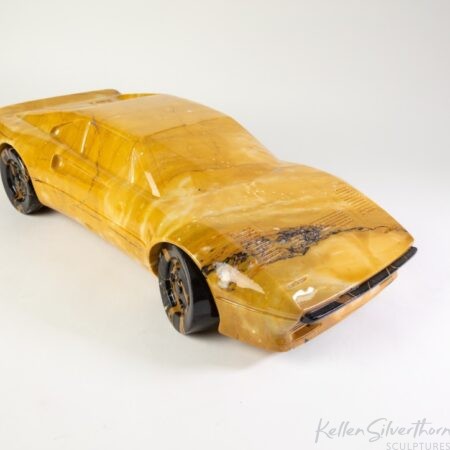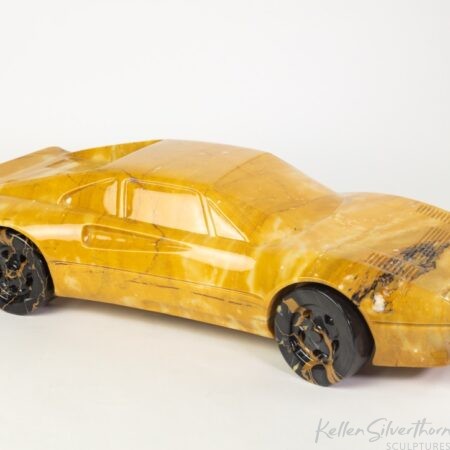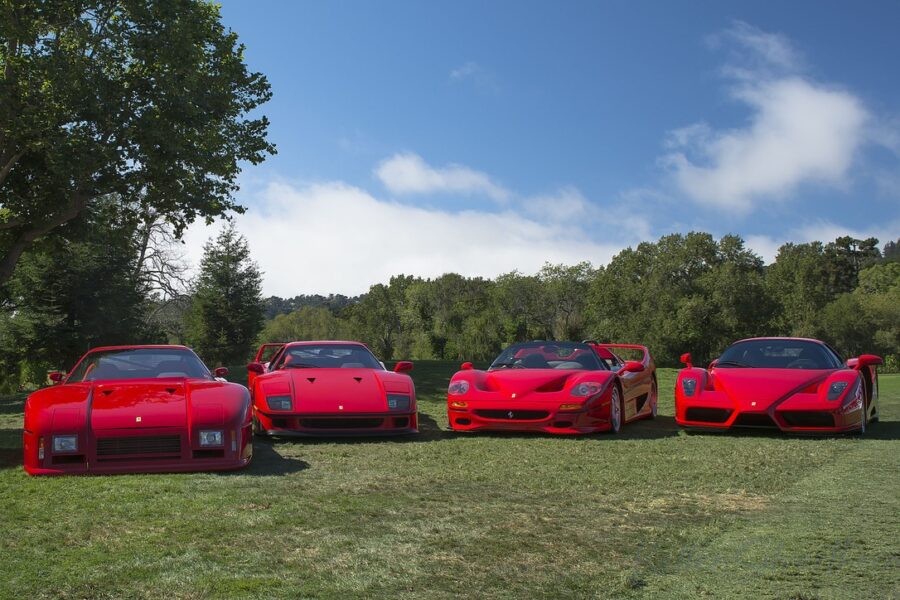RADwood WON – inspired by the Ferrari 288 GTO
THE CAR
Two ingredients were pivotal to the creation of the 288 GTO, Ferraris first modern supercar. First, the long-serving 308 GTB (1976-84); and secondly, the 1982 debut of FIA’s Group B regulations.
Group B, with an OEM-friendly 200 strong build run for homologation, enticed many manufacturers to throw their hats into the motorsport homologation ring. Most of the smaller engine displacement efforts were directed at the World Rallye Championship, where they made a huge splash….until banishment during 1987 for being too fast, given the crowd control of the era.
Porsche and Ferrari built the most notable Group B homologation efforts intended for circuit racing. Both the 1984-87 Ferrari 288 GTO and Porsche 959 (1986-88), took the turbocharged 2.85 Litre rule route. The Porsche a water-cooled flat 6, and the Ferrari with a 90-degree V8, each good for 400+ horsepower. Each base homologation model was built around 300 times, making them multi-million-dollar collectibles today.
Neither the 959, nor the 288, played a major role in motorsport history, with few race entries. In part, this result was due to the wild success of the contemporaneous top-billing Group C prototypes in top sports car events. As well, manufacturers intent on road racing a Group B would typically build the allowed 20-unit Evo spec cars for such efforts. Instead, both the 959 and 288 proved prophetic as to how each brands’ future production sports cars would evolve, as their cutting-edge technology would migrate through time downwards to lesser production models.
While the road-legal 1984 Ferrari GTO cranked out 400+ horsepower, its showroom-sharing naturally aspirated 3.0L 308 GTB was rated at 235hp. The cars were visually similar, with the 288 looking the testosterone-infused of the pair.
Differences to the 308 were more than skin and engine deep. Ferrari engineers decided to switch the engine / transaxle from a transverse (308) format, to a longitudinal format in the 288. This allowed the 288’s engine to be mounted lower. This necessitates the 288’s wheelbase to be roughly 4.3 inches longer than the 308. Front and rear track on the 288 were also 4” greater than the 308. Advanced materials weight saving throughout shed a substantial 250+ pounds, (some sources claim 500+ lbs saved), compared to a 308 GTB.
The 288 was arguably the first of a long string of street-legal, mid-engined Ferrari hot rods…. 288 GTO, F40, F50, Enzo, LaFerrari, SF90, etc.

288 GTO Evo, 1 of 6, Windsor Concours of Elegance, 2016 Photo Credit to Dave Rook
Indeed, in 1986 Ferrari debuted the far more extreme, racing-intended, less elegant 288 GTO Evoluzione, with 650 hp, 2150 pounds curb weight, and large raised wing.
Only 6 of the 288 Evos were made, and none raced by the factory or its surrogates. Nevertheless, the 288 Evo racer was then essentially reverse-engineered to a street car to debut as the iconic 1987 Ferrari F40.
______________________________________________________
American emissions and safety regulations of the 1970’s largely stifled the automotive enthusiast halcyon days of the mid-fifties through 1971. Group B regulations were a major catalyst for the re-awakening of high-performance technology and models for enthusiasts in the mid-1980s. The industry of serving-up automotive enthusiast-serving style and performance hasn’t really looked back since.
RADwood is a movement that celebrates 1980s and 1990s western-world automotive culture. Understandably, the 288 is near and dear to the hearts of Generation X, (born 1965-85). As one of the earliest, fastest, and most stylish cars of its era, I felt the appellation RADwood Won appropriate for this Ferrari 288 GTO-inspired sculpture. (Stay tuned for RADwood Too, a future Porsche 959 sculpture.)
THE STONE
It seemed like I’d done a number of recent sculptures in green, black, gunmetal, orange, and red. The time felt right to return to a yellow or gold hue. Among yellow painted cars, my favourites are usually Ferraris. I looked at a LOT of pictures of yellow Ferraris before deciding upon the 288 GTO. It is a fantastic looking car, an icon of its era, and a period for which I have created little to date in my portfolio.

The unicorn black 288 GTO, rumoured to have been executed for one of the F1 drivers. Photo credit to Matteo “TT” Stucchi
Coincidentally, Ferrari was celebrating its 75th anniversary and it‘s relationship to yellow body panels at Monza that same September. Driving suits and F1 race car trim were in vibrant sunny hues. The media explained that pre-war Enzo wanted his race team Alfa Romeos yellow, but national colors called for all Italians to race in red livery. Thus, why Enzo insisted the color background of the Prancing Horse logo be yellow.
Enzo was still quite involved with Ferrari in the early 1980s, though no longer calling all of the shots on the street car side. Still, given his passion for yellow it is surprising that all but one of the 288s produced were painted red. The sole exception is a black car.

A color changed 288, Wikimedia commons, Goodwood Fos 2011
Perhaps I’m somewhat righting a historical injustice with my proudly yellow RADwood Won.
Stone’Eng came through with the sourcing of the Giallo Sienna Marble from Italy. The background of ill-defined bands of yellow-gold is graced by whitish islands, and thin occasional veining in black, and maroon. I think it looks fantastic paired with the Portoro Fino inlays and wheels/tires.. I hope you agree.













